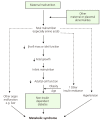What is fetal programming?: a lifetime health is under the control of in utero health
- PMID: 29184858
- PMCID: PMC5694724
- DOI: 10.5468/ogs.2017.60.6.506
What is fetal programming?: a lifetime health is under the control of in utero health
Abstract
The "Barker hypothesis" postulates that a number of organ structures and associated functions undergo programming during embryonic and fetal life, which determines the set point of physiological and metabolic responses that carry into adulthood. Hence, any stimulus or insult at a critical period of embryonic and fetal development can result in developmental adaptations that produce permanent structural, physiological and metabolic changes, thereby predisposing an individual to cardiovascular, metabolic and endocrine disease in adult life. This article will provide evidence linking these diseases to fetal undernutrition and an overview of previous studies in this area as well as current advances in understanding the mechanism and the role of the placenta in fetal programming.
Keywords: Chronic disease; Fetal development; Fetal nutrition disorders.
Conflict of interest statement
Conflict of interest: No potential conflict of interest relevant to this article was reported.
Figures








References
-
- Barker DJ. In utero programming of chronic disease. Clin Sci (Lond) 1998;95:115–128. - PubMed
-
- Widdowson EM, McCance RA. A review: new thoughts on growth. Pediatr Res. 1975;9:154–156. - PubMed
-
- Lucas A. Programming by early nutrition in man. In: Bock GR, Whelan J, editors. The childhood environment and adult disease. Chichester: John Wiley & Sons; 1991. pp. 38–55.
Publication types
LinkOut - more resources
Full Text Sources
Other Literature Sources

